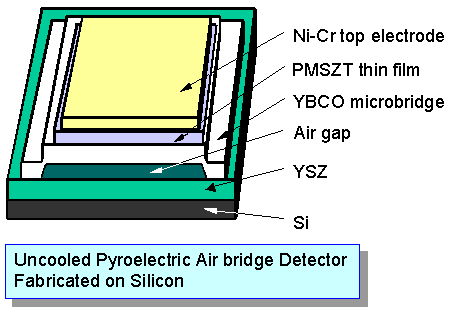Task Leader: Professor Nai Juan Wu at naijwu@uh.edu
Ferroelectric thin films, with their strong pyroelectric behavior, are currently being developed for
uncooled infrared detector and thermal imaging applications. These include both military and commercial
uses, ranging from night vision and surveillance to process control. Epitaxial doped-PbZrTiO3 (PZT)
films grown by pulsed laser deposition (PLD) have been integrated with silicon through the use of conducting
oxide electrodes and buffer layers. YBa2Cu3O7-x (YBCO) films have been used
at room temperature as conducting oxide electrodes, as well as an excellent template layer for epitaxial growth of the doped
PZT thin films. The high infrared reflectivity and low thermal conductivity of YBCO layers are effective
in increasing the detector's performance, and the epitaxial character of the films improves the pyroelectric
figures of merit Fv and Fd. The integration to silicon incorporates a yttria-stabilized zirconia
(YSZ) buffer layer resulting in a heterostructure detector with high detectivity of ~5 x 108 cmHz1/2/W
over the wavelength range of 1 mm to 20 mm. Additional sensitivity enhancement is obtained through the
development of YBCO microbridges on the YSZ/Si substrate. The air gap in the microbridge structure
effectively reduces the thermal mass of the PZT detector and results in a three-fold increase in
photoresponse in the modulation frequency range of 20 to 50 Hz.
|
Personnel: Dr. YuQing Xu: Senior Research Scientist Yanqi Wang: Research Assistant Wilfredo More: Postdoctoral Associate |

|
Related Uncooled IR Detector Publications
Space Vacuum Epitaxy Center
Web page created by Heidi Nussmeyer at hnussmey@bayou.uh.edu
Web Master: Dave Moore djmoore@uh.edu